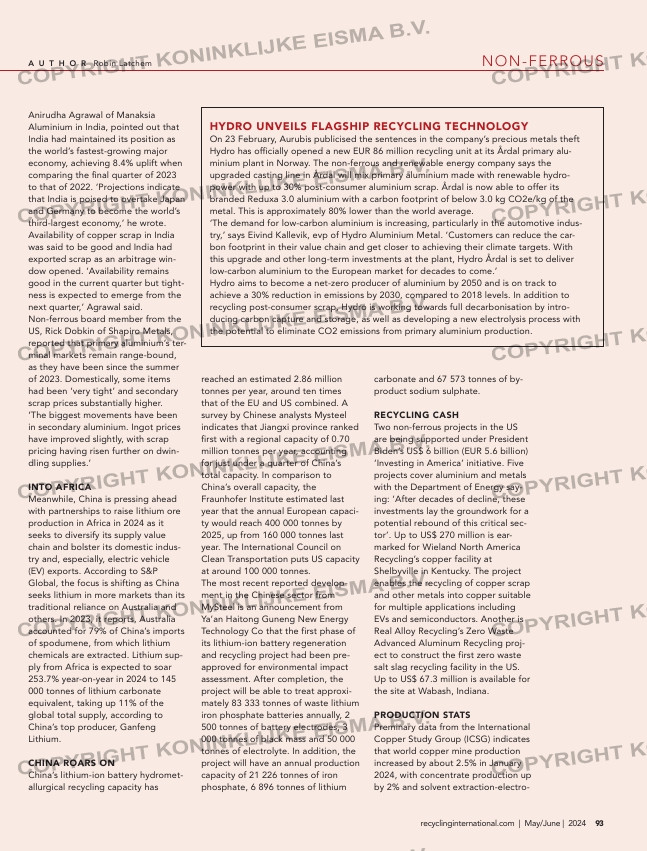Page 93 from: What’s inside?

NON-FERROUS
Caution despite price boost
Anirudha Agrawal of Manaksia
Aluminium in India, pointed out that
India had maintained its position as
the world’s fastest-growing major
economy, achieving 8.4% uplift when
comparing the final quarter of 2023
to that of 2022. ‘Projections indicate
that India is poised to overtake Japan
and Germany to become the world’s
third-largest economy,’ he wrote.
Availability of copper scrap in India
was said to be good and India had
exported scrap as an arbitrage win-
dow opened. ‘Availability remains
good in the current quarter but tight-
ness is expected to emerge from the
next quarter,’ Agrawal said.
Non-ferrous board member from the
US, Rick Dobkin of Shapiro Metals,
reported that primary aluminium’s ter-
minal markets remain range-bound,
as they have been since the summer
of 2023. Domestically, some items
had been ‘very tight’ and secondary
scrap prices substantially higher.
‘The biggest movements have been
in secondary aluminium. Ingot prices
have improved slightly, with scrap
pricing having risen further on dwin-
dling supplies.’
INTO AFRICA
Meanwhile, China is pressing ahead
with partnerships to raise lithium ore
production in Africa in 2024 as it
seeks to diversify its supply value
chain and bolster its domestic indus-
try and, especially, electric vehicle
(EV) exports. According to S&P
Global, the focus is shifting as China
seeks lithium in more markets than its
traditional reliance on Australia and
others. In 2023, it reports, Australia
accounted for 79% of China’s imports
of spodumene, from which lithium
chemicals are extracted. Lithium sup-
ply from Africa is expected to soar
253.7% year-on-year in 2024 to 145
000 tonnes of lithium carbonate
equivalent, taking up 11% of the
global total supply, according to
China’s top producer, Ganfeng
Lithium.
CHINA ROARS ON
China’s lithium-ion battery hydromet-
allurgical recycling capacity has
93recyclinginternational.com | May/June | 2024
A U T H O R Robin Latchem
HYDRO UNVEILS FLAGSHIP RECYCLING TECHNOLOGY
On 23 February, Aurubis publicised the sentences in the company’s precious metals theft
Hydro has officially opened a new EUR 86 million recycling unit at its Årdal primary alu-
minium plant in Norway. The non-ferrous and renewable energy company says the
upgraded casting line in Årdal will mix primary aluminium made with renewable hydro-
power with up to 30% post-consumer aluminium scrap. Årdal is now able to offer its
branded Reduxa 3.0 aluminium with a carbon footprint of below 3.0 kg CO2e/kg of the
metal. This is approximately 80% lower than the world average.
‘The demand for low-carbon aluminium is increasing, particularly in the automotive indus-
try,’ says Eivind Kallevik, evp of Hydro Aluminium Metal. ‘Customers can reduce the car-
bon footprint in their value chain and get closer to achieving their climate targets. With
this upgrade and other long-term investments at the plant, Hydro Årdal is set to deliver
low-carbon aluminium to the European market for decades to come.’
Hydro aims to become a net-zero producer of aluminium by 2050 and is on track to
achieve a 30% reduction in emissions by 2030, compared to 2018 levels. In addition to
recycling post-consumer scrap, Hydro is working towards full decarbonisation by intro-
ducing carbon capture and storage, as well as developing a new electrolysis process with
the potential to eliminate CO2 emissions from primary aluminium production.
reached an estimated 2.86 million
tonnes per year, around ten times
that of the EU and US combined. A
survey by Chinese analysts Mysteel
indicates that Jiangxi province ranked
first with a regional capacity of 0.70
million tonnes per year, accounting
for just under a quarter of China’s
total capacity. In comparison to
China’s overall capacity, the
Fraunhofer Institute estimated last
year that the annual European capaci-
ty would reach 400 000 tonnes by
2025, up from 160 000 tonnes last
year. The International Council on
Clean Transportation puts US capacity
at around 100 000 tonnes.
The most recent reported develop-
ment in the Chinese sector from
MySteel is an announcement from
Ya’an Haitong Guneng New Energy
Technology Co that the first phase of
its lithium-ion battery regeneration
and recycling project had been pre-
approved for environmental impact
assessment. After completion, the
project will be able to treat approxi-
mately 83 333 tonnes of waste lithium
iron phosphate batteries annually, 2
500 tonnes of battery electrodes, 3
000 tonnes of black mass and 50 000
tonnes of electrolyte. In addition, the
project will have an annual production
capacity of 21 226 tonnes of iron
phosphate, 6 896 tonnes of lithium
carbonate and 67 573 tonnes of by-
product sodium sulphate.
RECYCLING CASH
Two non-ferrous projects in the US
are being supported under President
Biden’s US$ 6 billion (EUR 5.6 billion)
‘Investing in America’ initiative. Five
projects cover aluminium and metals
with the Department of Energy say-
ing: ‘After decades of decline, these
investments lay the groundwork for a
potential rebound of this critical sec-
tor’. Up to US$ 270 million is ear-
marked for Wieland North America
Recycling’s copper facility at
Shelbyville in Kentucky. The project
enables the recycling of copper scrap
and other metals into copper suitable
for multiple applications including
EVs and semiconductors. Another is
Real Alloy Recycling’s Zero Waste
Advanced Aluminum Recycling proj-
ect to construct the first zero waste
salt slag recycling facility in the US.
Up to US$ 67.3 million is available for
the site at Wabash, Indiana.
PRODUCTION STATS
Preminary data from the International
Copper Study Group (ICSG) indicates
that world copper mine production
increased by about 2.5% in January
2024, with concentrate production up
by 2% and solvent extraction-electro-
92-93-94_manonferrous.indd 93 24-04-2024 14:32



